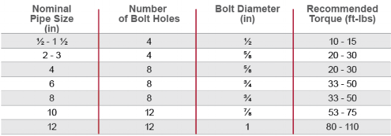Installing Corzan® CPVC with Flanging
Flanging
Flanging can be used to provide temporary disassembly of a piping system or can be used when it is not possible to make solvent cemented joints at the assembly site. Flanges are joined to the pipe by solvent cement or threaded joints. Flanged joints incorporate an elastomeric gasket between the mating faces to provide a seal. The gasket selected must be full-faced and have a hardness of 55-80 durometer A. Typically, gaskets are 1/8-inch thick, and the material must be resistant to the chemical environment it will be exposed to and chemically compatible with CPVC.
Check with the gasket material manufacturer on resistance and compatibility information. If the piping system is for potable water service, the gasket must also be approved for potable water.
The flanges should be carefully aligned and the bolts inserted through matching holes. Use a flat washer beneath each nut and bolt head. Each bolt should be partially tightened in the alternating sequence as indicated in the patterns below. A torque wrench should be used for the final tightening of the bolts.
Flange Bolt Tightening Patterns
Use this alternating sequence when tightening the bolts.

Recommended Bolt Torque
Flange joints are typically rated to 150 psi at 73°F (22.8°C). For systems operating at higher temperatures, the flange pressure rating should be derated per the manufacturer’s recommendations.

Get Customized Training on Installing Corzan CPVC
We know every project made with Corzan CPVC is unique. Fill out the form to discuss and schedule customized training.

Submit the form and an expert will be in touch within one business day.